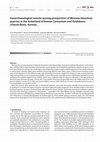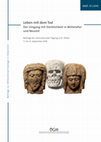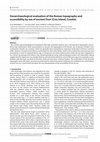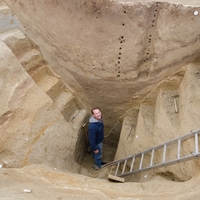Papers by Erich Draganits
In: Kremer, G., Pollhammer, E., Kopf, J. & Beutler (Hrsg.). ZEIT(EN) DES UMBRUCHS Akten des 17. Internationalen Kolloquiums zum provinzialrömischen Kunstschaffen Wien – Carnuntum, 16.–21. Mai 2022. Veröff. Landessamml. Niederösterr. 7, und ÖAI Sonderschriften 64, 2024
Maria-Pia Darblade-Audoin Les hermès de Welschbillig. Style et technique au IV e siècle dans le N... more Maria-Pia Darblade-Audoin Les hermès de Welschbillig. Style et technique au IV e siècle dans le Nord des Gaules ....
In: Alexandridou, A., Kourayos, Y. & Daifa, I. (eds.), Despotiko, the site of Mandra: The “Temple” complex and its deposits. Babesch Supplements, 46, Peeters, Leuven, pp. 59-78, 2023
In: Neubauer, W. & Kowatschek, I. (eds.), Forschungen in Schwarzenbach: Die Forschungen in den Jahren 1992-2008. Studien zur Eisenzeit im Ostalpenraum, 3, Archaeolingua, Budapest, pp. 129-148, 2023

Journal of Archaeological Science: Reports 48 (2023) 103842, 2023
Osteometric data and morphological observations on cattle bones from Roman period sites from pres... more Osteometric data and morphological observations on cattle bones from Roman period sites from present-day
Austria suggest the arrival of a new large-sized cattle population, which has been connected with the
conquest of this area by the Romans and subsequent import of a Mediterranean population. Therefore, recent
documentation of some large-sized cattle remains, similar to those found in the Roman period, already from two
Late Iron Age sites, one even north of the Danube, indicate an earlier presence of this cattle population together
with the typical small-sized Iron Age cattle population. We applied ancient mitochondrial DNA analysis on
fourteen Iron Age and Roman period cattle teeth and bones to find genetic evidence concerning possible cattle
mobility. Our results show the presence of haplogroup T3, a common European haplogroup, for both large-sized
(imported) and small-sized (Iron Age) cattle. For the first time in present-day Austria, our documentation of
haplogroups T1 (common in cattle populations from southern Europe) and T5 (so far recorded only in Italian and
some Croatian cattle populations probably due to Mediterranean influence) in the Iron Age large-sized cattle
provides evidence for cattle imports from the Mediterranean already during the Iron Age.

We have documented quarries in Miocene limestone in the Vienna Basin (Austria), Hundsheim Mountai... more We have documented quarries in Miocene limestone in the Vienna Basin (Austria), Hundsheim Mountains, Leitha Mountains and Rust Hills in high-resolution airborne laser scanning data and orthophotos aiming for a diachronic quarry inventory since the Roman period. The study region was divided into 6 quarry regions and the quarries of the whole study area as well as each separate region were analyzed concerning different rock types, mean, minimum and maximum quarry area and development in the different maps. Age information have been sought from historical maps, historical photography and paintings as well as quarry face graffiti. In total, 658 quarries, possible quarries and shallow quarries have been outlined in the detailed digital terrain models, which were compared with 453 quarries indicated in four generations of historical maps between the years 1754 to 1872. The numbers of quarries are generally low in the Walter map (1754–1756), the First Military Survey (1773–1785) and Second Military Survey (1809–1846) but increase tremendously in the maps of the Third Military Survey (1872–1873).
Most old quarries were quarried also in subsequent periods, commonly destroying virtually all pre-existing traces. According to our results two types of quarries represent highly interesting targets for more detailed studies in the search for Roman quarries: (i) areas in historical maps with suspicious uneven terrain, which have never been outlined as quarries and areas that have been mapped as “old quarries” – especially in the Third Military Survey; examples represent areas northwest and west of Pfaffenberg in Bad Deutsch-Altenburg (Lower Austria), “Gruibert” in Winden am See (Burgenland) and “Hoher Berg” in Stotzing (Burgenland); (ii) Shallow quarries, which neither appear in historical maps nor in the mining archive of the Geological Survey of Austria like the one from the saddle between Pfaffenberg and Hundsheimer Berg.
Gols in der Nähe des Neusiedlersees, ungarisch Fertő. 4 Wüstung Pahlendorf; benannt nach dem mitt... more Gols in der Nähe des Neusiedlersees, ungarisch Fertő. 4 Wüstung Pahlendorf; benannt nach dem mittelalterlichen Kleinadeligen Beled aus dem Geschlecht der Osl. 5 Etymologie unbekannt, ebenso wie vom später genannten Thaetas. 6 Der aus dem ungarischen "határ" übernommene Begriff Hotter bezeichnet einerseits die gesamte Gemarkung eines Ortes, andererseits die Marchzeichen selber. 7 Thaetas und Langtal sind als Toponyme heute nicht mehr bekannt. 8 Das heutige Hegyeshalom an der ungarischen Grenze, zu Deutsch Strass-Sommerein.
Fundberichte aus Österreich 58/2019, 2021
Fifth preliminary report about the excavations of an roman, migration period and early medieval s... more Fifth preliminary report about the excavations of an roman, migration period and early medieval settlement next to the lake Neusiedl (Fertö-tó) (2nd-7th century AD).

In: T. Kühtreiber/R. Risy/G. Scharrer-Liška/C. Theune (Hrsg.), Leben mit dem Tod. Der Umgang mit Sterblichkeit in Mittelalter und Neuzeit. Beiträge der internationalen Tagung in St. Pölten 11. bis 15. September 2018. Beiträge zur Mittelalterarchäologie in Österreich 35 , 2020
This study presents for the first time the early medieval
cemetery of Podersdorf am See in its la... more This study presents for the first time the early medieval
cemetery of Podersdorf am See in its landscape archaeological,
diachronic context. The interdisciplinary methods applied
show the cemetery in a completely unexpected dense
spatial setting, with additional cemeteries, settlements and
roads, over a time span reaching from the Roman Empire
Period, through the Migration Period to the Middle Ages.
Change in burial customs in Eastern Austria during the
1st millennium AD is discussed based on the case study of
the early medieval cemetery at Podersdorf. Animal bones
and composite bows are among the regular grave goods that
remained in the graves there despite deliberate looting. The anthropological evaluation of the skeletons from Podersdorf
allows these grave goods to be seen from a new perspective.
A special feature was the discovery of a pit house directly
north of the cemetery. The burial of five individuals
inside the building, two of whom were positioned in a
foetal posture, is unusual in this form in the second half of
the 7th century. Using aDNA analysis, it was possible for the
first time to prove family relationships between such „deviant
burials“
New Global Perspectives on Archaeological Prospection: 13th International Conference on Archaeological Prospection, 28 August - 1 September 2019, Sligo, Ireland, 2019
D. Matetić Poljak – K. Marasović (Hrsg.), Proceedings of the XI ASMOSIA Conference, Split 2015 , 2018
Diego Peirano 15 17 25 33 45 65 79 89 95 101 109 117 123 6
Fundberichte aus Österreich, 2019
Third preliminary report about the excavations of an early medieval cemetery and settlement next ... more Third preliminary report about the excavations of an early medieval cemetery and settlement next to the lake Neusiedl (Fertö-tó) (7th century AD).
Archaeological Prospection, 2017

We combine geoarchaeological investigations with high-resolution airborne laser scanning (ALS) to... more We combine geoarchaeological investigations with high-resolution airborne laser scanning (ALS) topographic and airborne laser bathymetric (ALB) measurements to reassess the topography of the Roman city of Apsorus (modern Osor, northeastern Adriatic Sea, Croatia), which has generally been interpreted as important nodal point of Roman maritime traffic. Apsorus is located at the isthmus connecting Cres and Lošinj islands, which is 90 m wide at the narrowest part and dissected by a canal of supposed Roman age. A conspicuous low-lying wetland north of the city has been suggested to be a former sea passage and harbour area. Geoarchaeological coring, sedimentological analysis and radiocarbon dating suggest that this depression was already silted up with terrestrial sediments some 6,000 years ago and, especially in combination with the lower sea-level at that time, could not have been a Roman harbour. The combination of the ALS/ALB topographic data with lower sea-levels reconstructed for the Roman period challenges the traditional view which places ancient Osor on a small island and allows for new interpretations of the accessibility of Osor by sea.
Berichte der Geologischen Bundesanstalt, 2018
example / Beispiel): Fuchs,
31. Araştırma Sonuçları Toplantısı 2. Cilt, 2014

Uploads
Papers by Erich Draganits
Austria suggest the arrival of a new large-sized cattle population, which has been connected with the
conquest of this area by the Romans and subsequent import of a Mediterranean population. Therefore, recent
documentation of some large-sized cattle remains, similar to those found in the Roman period, already from two
Late Iron Age sites, one even north of the Danube, indicate an earlier presence of this cattle population together
with the typical small-sized Iron Age cattle population. We applied ancient mitochondrial DNA analysis on
fourteen Iron Age and Roman period cattle teeth and bones to find genetic evidence concerning possible cattle
mobility. Our results show the presence of haplogroup T3, a common European haplogroup, for both large-sized
(imported) and small-sized (Iron Age) cattle. For the first time in present-day Austria, our documentation of
haplogroups T1 (common in cattle populations from southern Europe) and T5 (so far recorded only in Italian and
some Croatian cattle populations probably due to Mediterranean influence) in the Iron Age large-sized cattle
provides evidence for cattle imports from the Mediterranean already during the Iron Age.
Most old quarries were quarried also in subsequent periods, commonly destroying virtually all pre-existing traces. According to our results two types of quarries represent highly interesting targets for more detailed studies in the search for Roman quarries: (i) areas in historical maps with suspicious uneven terrain, which have never been outlined as quarries and areas that have been mapped as “old quarries” – especially in the Third Military Survey; examples represent areas northwest and west of Pfaffenberg in Bad Deutsch-Altenburg (Lower Austria), “Gruibert” in Winden am See (Burgenland) and “Hoher Berg” in Stotzing (Burgenland); (ii) Shallow quarries, which neither appear in historical maps nor in the mining archive of the Geological Survey of Austria like the one from the saddle between Pfaffenberg and Hundsheimer Berg.
cemetery of Podersdorf am See in its landscape archaeological,
diachronic context. The interdisciplinary methods applied
show the cemetery in a completely unexpected dense
spatial setting, with additional cemeteries, settlements and
roads, over a time span reaching from the Roman Empire
Period, through the Migration Period to the Middle Ages.
Change in burial customs in Eastern Austria during the
1st millennium AD is discussed based on the case study of
the early medieval cemetery at Podersdorf. Animal bones
and composite bows are among the regular grave goods that
remained in the graves there despite deliberate looting. The anthropological evaluation of the skeletons from Podersdorf
allows these grave goods to be seen from a new perspective.
A special feature was the discovery of a pit house directly
north of the cemetery. The burial of five individuals
inside the building, two of whom were positioned in a
foetal posture, is unusual in this form in the second half of
the 7th century. Using aDNA analysis, it was possible for the
first time to prove family relationships between such „deviant
burials“
Austria suggest the arrival of a new large-sized cattle population, which has been connected with the
conquest of this area by the Romans and subsequent import of a Mediterranean population. Therefore, recent
documentation of some large-sized cattle remains, similar to those found in the Roman period, already from two
Late Iron Age sites, one even north of the Danube, indicate an earlier presence of this cattle population together
with the typical small-sized Iron Age cattle population. We applied ancient mitochondrial DNA analysis on
fourteen Iron Age and Roman period cattle teeth and bones to find genetic evidence concerning possible cattle
mobility. Our results show the presence of haplogroup T3, a common European haplogroup, for both large-sized
(imported) and small-sized (Iron Age) cattle. For the first time in present-day Austria, our documentation of
haplogroups T1 (common in cattle populations from southern Europe) and T5 (so far recorded only in Italian and
some Croatian cattle populations probably due to Mediterranean influence) in the Iron Age large-sized cattle
provides evidence for cattle imports from the Mediterranean already during the Iron Age.
Most old quarries were quarried also in subsequent periods, commonly destroying virtually all pre-existing traces. According to our results two types of quarries represent highly interesting targets for more detailed studies in the search for Roman quarries: (i) areas in historical maps with suspicious uneven terrain, which have never been outlined as quarries and areas that have been mapped as “old quarries” – especially in the Third Military Survey; examples represent areas northwest and west of Pfaffenberg in Bad Deutsch-Altenburg (Lower Austria), “Gruibert” in Winden am See (Burgenland) and “Hoher Berg” in Stotzing (Burgenland); (ii) Shallow quarries, which neither appear in historical maps nor in the mining archive of the Geological Survey of Austria like the one from the saddle between Pfaffenberg and Hundsheimer Berg.
cemetery of Podersdorf am See in its landscape archaeological,
diachronic context. The interdisciplinary methods applied
show the cemetery in a completely unexpected dense
spatial setting, with additional cemeteries, settlements and
roads, over a time span reaching from the Roman Empire
Period, through the Migration Period to the Middle Ages.
Change in burial customs in Eastern Austria during the
1st millennium AD is discussed based on the case study of
the early medieval cemetery at Podersdorf. Animal bones
and composite bows are among the regular grave goods that
remained in the graves there despite deliberate looting. The anthropological evaluation of the skeletons from Podersdorf
allows these grave goods to be seen from a new perspective.
A special feature was the discovery of a pit house directly
north of the cemetery. The burial of five individuals
inside the building, two of whom were positioned in a
foetal posture, is unusual in this form in the second half of
the 7th century. Using aDNA analysis, it was possible for the
first time to prove family relationships between such „deviant
burials“